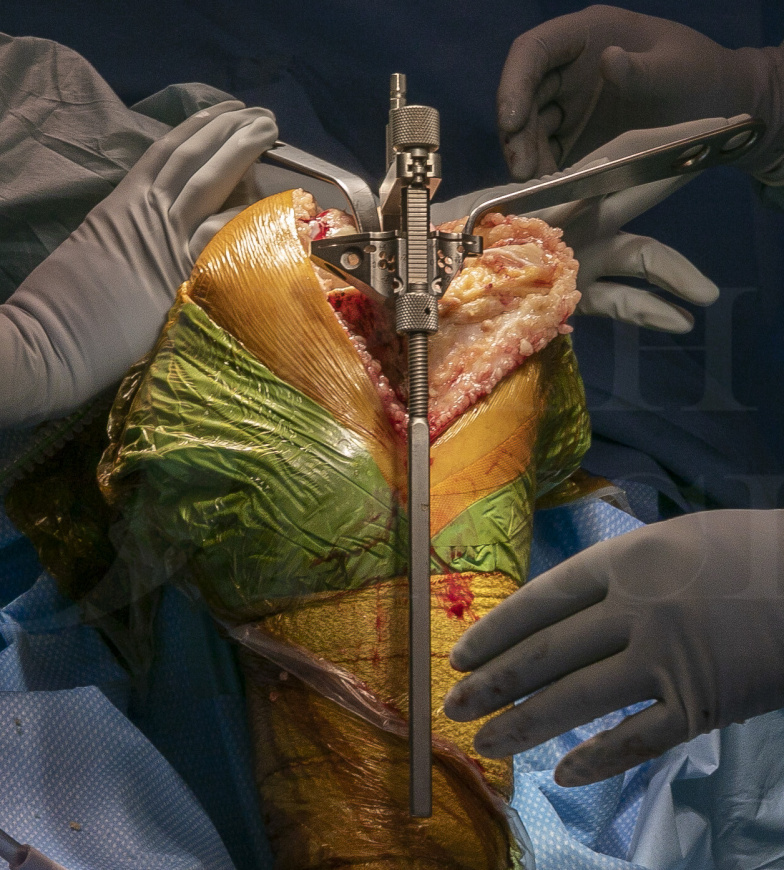Total Knee replacement: Zimmer Biomet Nexgen rotating hinge replacement
Overview

Subscribe to get full access to this operation and the extensive Knee Surgery Atlas.
Learn the Total Knee replacement: Zimmer Biomet Nexgen rotating hinge replacement surgical technique with step by step instructions on OrthOracle. Our e-learning platform contains high resolution images and a certified CME of the Total Knee replacement: Zimmer Biomet Nexgen rotating hinge replacement surgical procedure.
Learn the Rotating Hinge Total Knee Replacement- Nexgen Rotating Hinge (RH) Knee (Zimmer) surgical technique with step by step instructions on OrthOracle. Our e-learning platform contains high resolution images and a certified CME of this RH knee for medial collateral ligament deficiency with valgus deformity.
The NexGen RH Knee features a bone conserving modular hinge design that addresses key issues related to many conventional rotating hinge knee designs. The hinge system utilizes the same stems, cones, patellas, and both Trabecular Metal™ and Precoat augments as the NexGen LCCK Constrained Knee System. Bone cuts for the RH Knee system are similar to those of the LCCK system. This feature allows bone conservation as well as easy intra-operative conversions from LCCK.
In many conventional rotating hinge knee designs, the hinge mechanism bears the majority of the compressive load until full extension is achieved. Designs that have the centre of rotation located posteriorly can cause “booking” of the joint, which may result in stress on the cement interfaces or accelerated polyethylene bearing wear in the hinge.
The NexGen RH Knee addresses these concerns as the RH Knee femoral component and articular surfaces are designed to maintain centralized contact throughout ROM (from -3° of hyperextension to 120°) resulting in 95% condylar loading through the tibial condyles.
This is the case of a 91 year old lady who had developed tricompartmental osteoarthritis and medial collateral ligament deficiency leading to valgus deformity. In such case a surgeon may choose to use an implant with less constraint such as a posterior stabilised design, however these can still develop instability and require revision to a hinged knee.
In this technique I will focus on the arthroplasty technique using the Nexgen RH Knee.
The important points to assess preoperatively include attention to instability symptoms in the history and evidence of valgus deformity clinically and radiographically in the coronal plane. Examination often reveals frank medial collateral ligament deficiency and therefore in this situation the surgeon should have a low threshold for proceeding to full constraint with a rotating hinge design.
OrthOracle readers will also find the following techniques of interest:
Revision total Knee Replacement- Legion Rotating Hinge Knee ( Smith and Nephew)
Revision total Knee Replacement: Legion CCK (Smith and Nephew)
Total Knee replacement: Mako Triathlon robotic assisted cruciate retaining TKR (STRYKER)
Total Knee replacement: MAKO robotic triathlon cruciate substituting knee replacement
Total knee replacement Genesis 2 (PS) with bi-convex patella (Smith and Nephew)
Total knee replacement: Vanguard XP cruciate retaining (Zimmer-Biomet)
Total knee replacement-Triathlon (Stryker) posterior stabilised knee.
Total knee replacement (posterior stabilised): Visionaire Genesis II (Smith and Nephew)
Total Knee Replacement: De Puy Attune implant
Total Knee Replacement: Vanguard cruciate retaining knee replacement(Zimmer-Biomet)
Total Knee replacement: Vanguard 360 knee replacement (Zimmer-Biomet)
Author: Kenny Rankin FRCS (Tr & Orth)
Institution: The Freeman Hospital, Newcastle, UK.
Clinicians should seek clarification on whether any implant demonstrated is licensed for use in their own country.
In the USA contact: fda.gov
In the UK contact: gov.uk
In the EU contact: ema.europa.eu
Online learning is only available to subscribers.



















